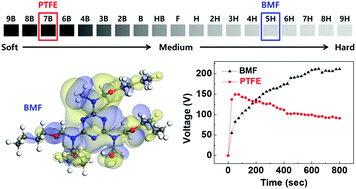Butylated melamine formaldehyde as a durable and highly positive friction layer for stable, high output triboelectric nanogenerators†
Abstract
Mechanical durability and the triboelectric property of the friction layer are crucial for obtaining stable high power output from triboelectric nanogenerators (TENGs). Here, we introduce butylated melamine formaldehyde (BMF) as a promising triboelectric material because of both its mechanical durability and its highly positive triboelectric property. These unique characteristics originate from its functional group, which contains hydrogen atoms. Kelvin probe force microscopy measurements and density functional theory calculations confirm that BMF is triboelectrically more positive than are pristine MF and methylated MF. In addition, the Young's modulus, calculated by molecular dynamics simulations, of BMF is six times higher than that of polytetrafluoroethylene (PTFE). Additionally, BMF has demonstrated a lower wear rate than PTFE in an abrasion test with Cu as the counter friction material. Because of the superior mechanical and triboelectric characteristics, the root-mean-square output of a rotation-type BMF based TENG [210 V and 125 μA (24 mA m−2)] is higher than that of the one with PTFE [90 V and 31 μA (5.9 mA m−2)] and remained stable over extended operation of 27 000 cycles. BMF thus offers an opportunity for fabricating high-performance TENGs with applications in self-powered smart systems.



 Please wait while we load your content...
Please wait while we load your content...